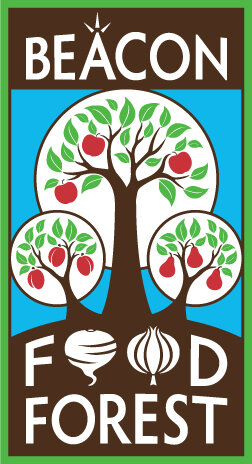What is a food forest?
Beacon Food Forest combines agroforestry and design principles to create a diverse and resilient edible landscape
Agroforestry (or forest gardening) is a land use system in which trees, shrubs and agricultural crops are interspersed. This creates a multi-story ecosystem that can mimic the self-sustaining functions of a natural forest while incorporating food plants for human consumption. The result is a semi-natural landscape that requires far less maintenance than row crops, provides habitat for pollinators, bugs and birds, and can sustain perennial as well as annual food plants.
In a food forest, each fruit or nut tree is at the center of a plant guild. A guild is a beneficial grouping of plants that support one another in all their functions.
Beacon Food Forest consists of the following areas:
Food forest: This semi-natural area is made up of fruit and nut tree guilds and berry bushes. Groundcover includes some edible greens like kale and chard. Perennial plants are dispersed all over the site (including edible plants such as sunchokes, orache, burdock, cardoon).
Helix vegetable garden: The 2,000 square foot garden grows annual greens, roots, squash and nightshades. More familiar food plants are an easy entry point into foraging at Beacon Food Forest.
Medicinal and culinary herbs: There are several herb gardens/spirals and individual plants around the site.
Gathering and teaching spaces: Phase 1 and Phase 2 of the Beacon Food Forest project each have a large gathering plaza with benches next to a tool shed and notice board/map. This is where our potlucks and workshops take place and visitors can rest and observe the site.
Native plant guild: The wetland and prairie at the southeast border of the site have been restored and now grow native food plants such as wapato, camas and native berries, as well as grasses traditionally used for basket weaving.
Phase 2 expansion
All of these different areas will be extended or replicated in the Phase 2 expansion on the north side of the site. This will add another 1.75 acres of cultivated land, doubling the size of the food forest and bringing the project halfway to the full land allotment of 7 acres.
We have taken special care to obtain recycled, natural, and long-lasting materials wherever possible. Walls are built from urbanite (slabs of recycled concrete, e.g. from sidewalks), steps and hose bib posts are made of natural cedar wood.
Beacon Food Forest volunteers are working in conjunction with the Seattle Conservation Corps, Barker Landscape Architects, and the Seattle Department of Neighborhoods P-Patch Program to expand ADA accessibility in Phase 2. This work includes grading pathways and building raised P-Patch gardening beds and open harvest trellises.


